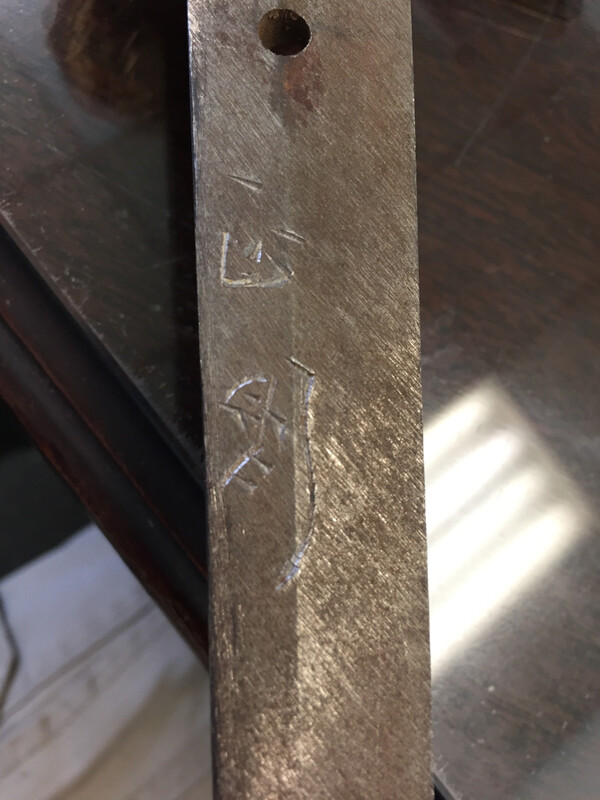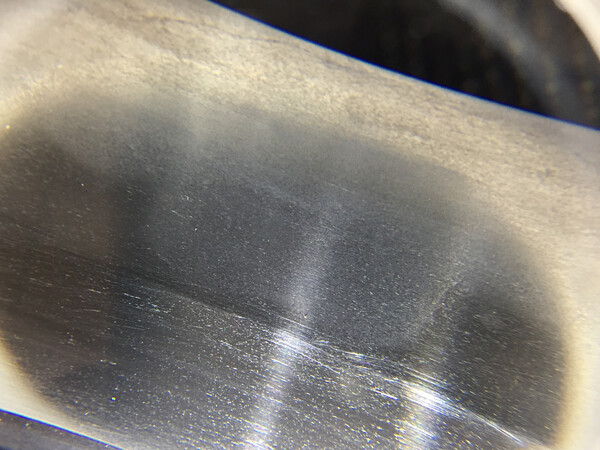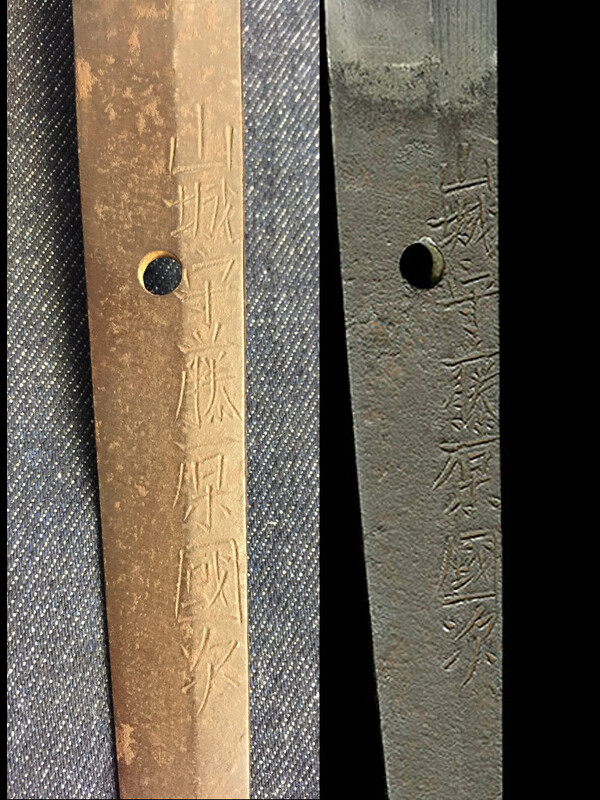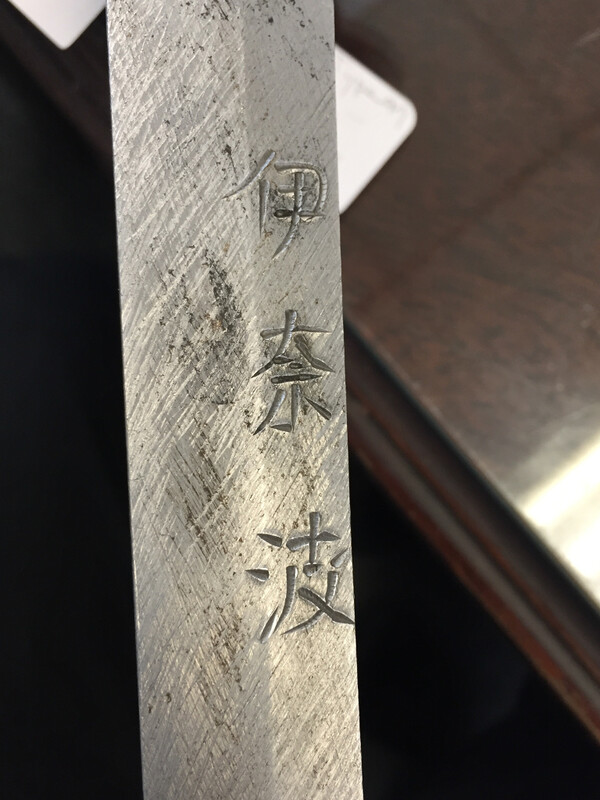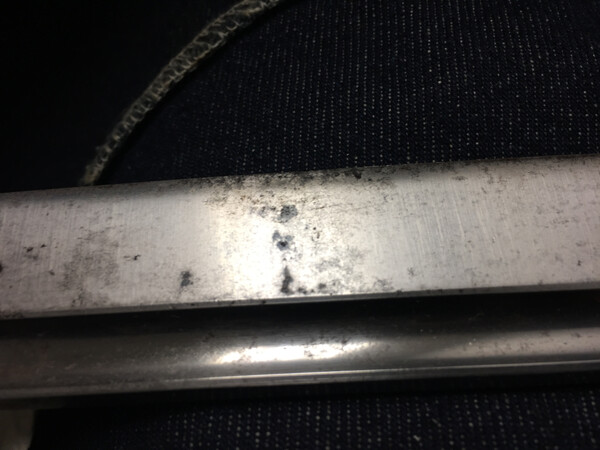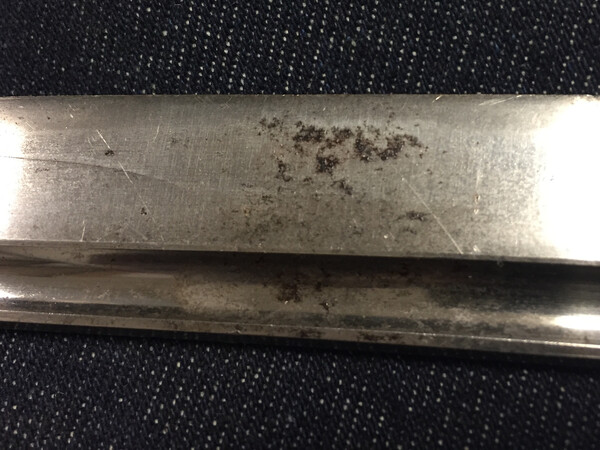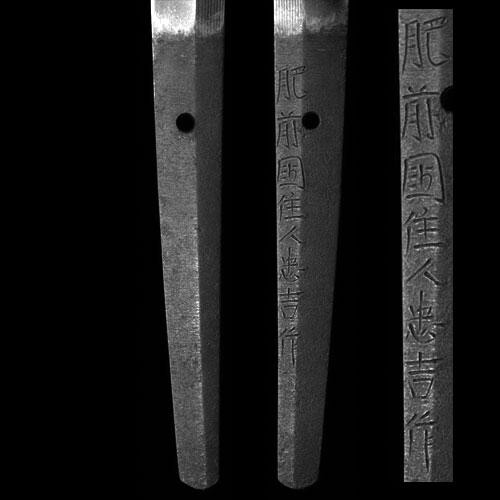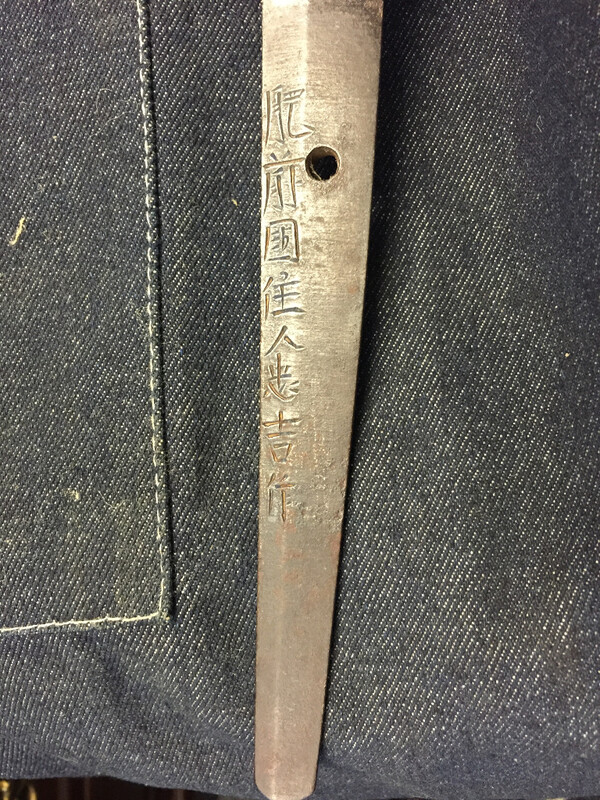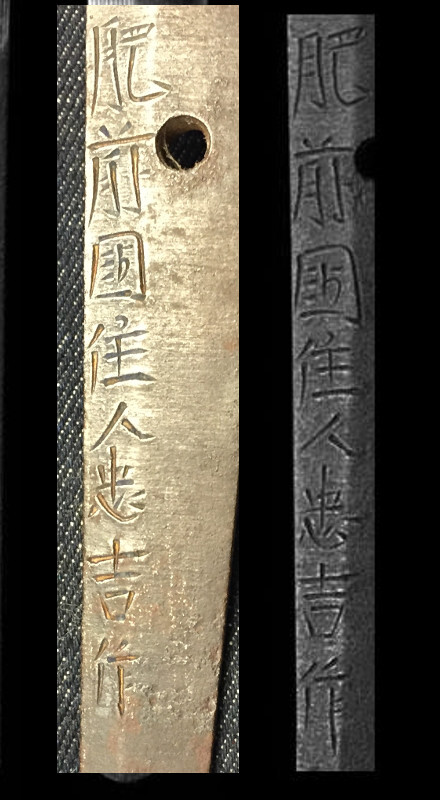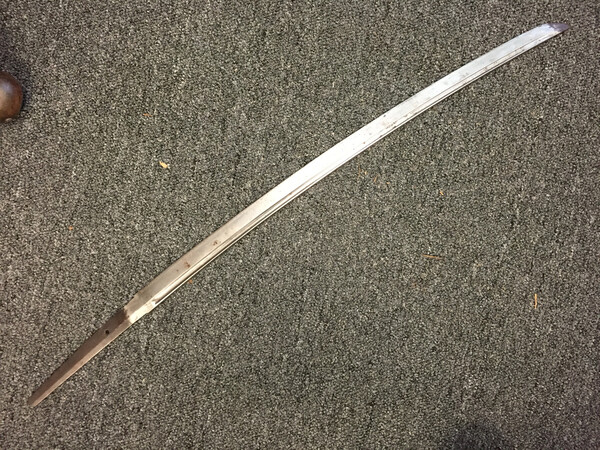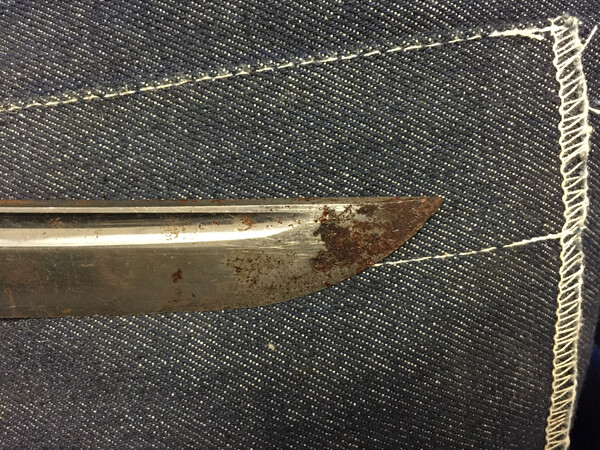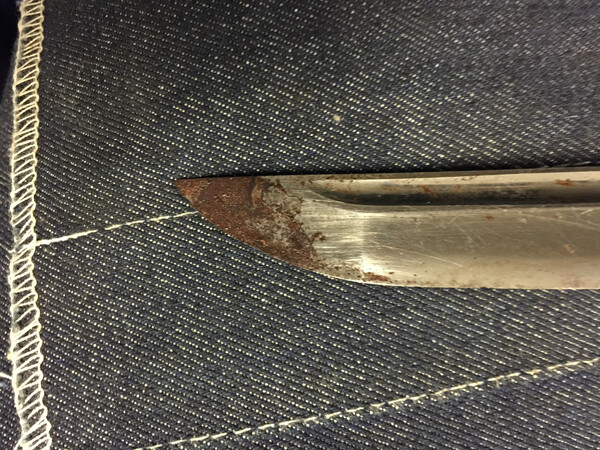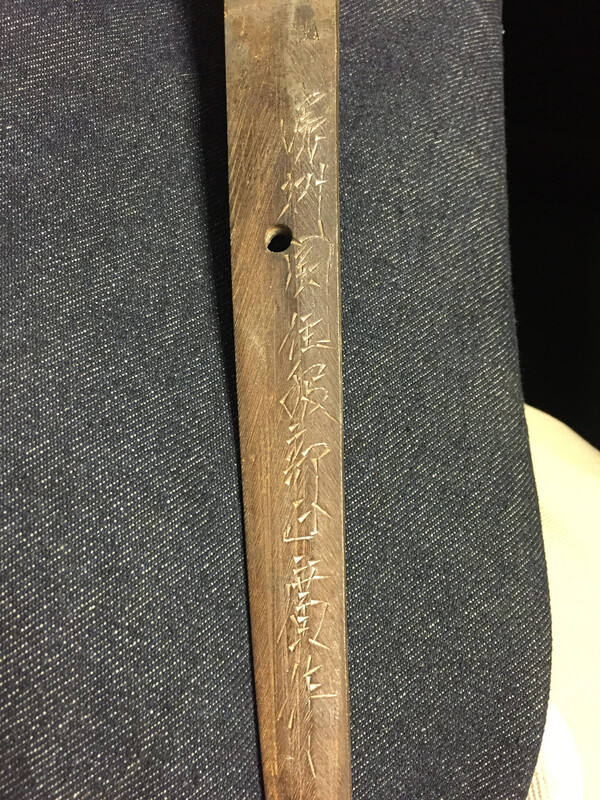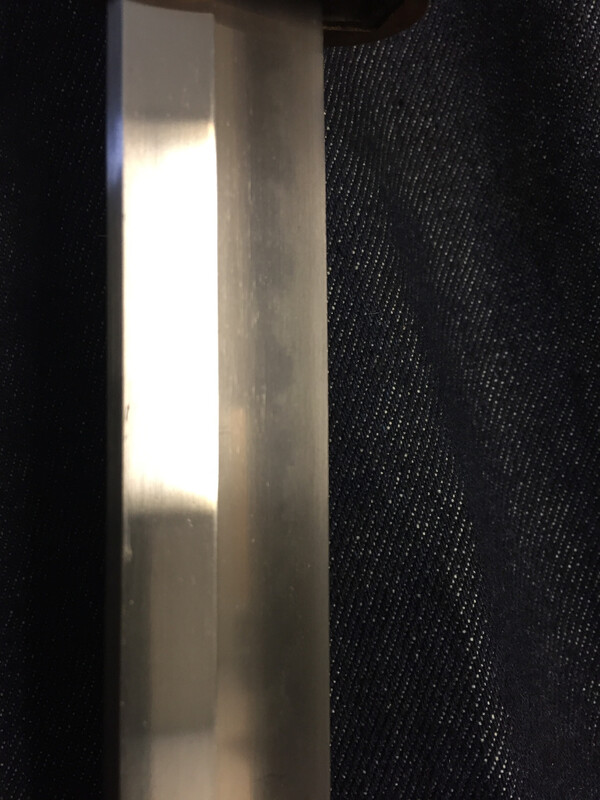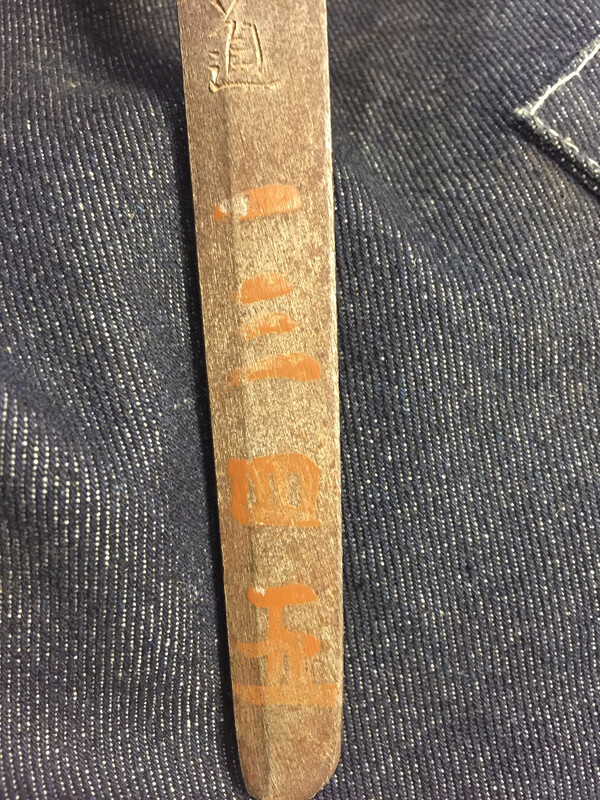
tbonesullivan
Members-
Posts
394 -
Joined
-
Last visited
Content Type
Profiles
Forums
Events
Store
Downloads
Gallery
Everything posted by tbonesullivan
-
I thought I had gotten pretty good at reading mei, but this one is giving me trouble. It's from a 1944 dated blade, so it's late war, and the mei looks somewhat rushed. I am reading it as 包 則 - KANE NORI It doesn't match any of the Oshigata I have found, as they usually use the 兼 character for KANE. I could also be mis reading the first kanji entirely. My second choice would be 正 則 - MASANORI Thoughts? Thanks in advance!
-
Saya finish - whats it called?
tbonesullivan replied to Barrie B's topic in General Nihonto Related Discussion
Oh dang! That definitely took lots of hours to do. Lovely! -
The matching numbers are interesting, and sometimes they mix together Japanese and Western numbers, just like with dates on other WWII Military Items. Most of the pretty much "unissued" late war Kai Gunto i have seen have no signature, just the Anchor Stamp, and a painted number. They also tend to have black lacquered scabbards, not "shagreen", with oil cloth in the handle.
-
平 can be read as Hira, Taira, or Hei. Most of the smith names in the lists have it as "Hira". "Taira" is a clan name. So, it would be 平 俊 作 . I've seen Toyokawa arsenal marked blades that have no signature, or that do. I also have seen them with or without the matching number for the Koshirae. There isn't any hard and fast rule. In fact, the minority that I have handled had stamped western matching numbers. Most were painted on with Japanese numerals.
-
Well, I think the one thing that is clear is that it's not clear what it is. I hopefully will be able to bring it to the NY Token Kai meeting at the end of the month, and hopefully get some people to look at it first hand. There is definitely chattoyancy in the Hamon. I managed to take some photos with my phone and a 16X lighted magnifier. The hamon is definitely not just someone going wild with hadori.
-
Replacing gunto tsuka
tbonesullivan replied to brocksamson7's topic in General Nihonto Related Discussion
Is it real ray skin or synthetic? You can always get it re-wrapped with fresh new ray skin, and you know it'll fit. That's probably the most cost effective solution to get the end result you desire. -
There is no Kikumon on the tang, or any trace I can see. The reverse of the tang is completely blank. There are some traces of the Yasuri-Me , which stops just above the signature, slanting in the same direction as the examples I've seen. Also, that link you posted is to a different page with the exact same sword I linked to. I have found two others: This one has straight horizontal strokes, but is not papered. I make a crappy comparison photo. http://kako.nipponto.co.jp/swords2/KT219262.htm This one has the more curved horizontal strokes, and is papered. https://www.k-sword.com/goods.php?id=872
-
Sure! The blade length is 28 inches / 71.1 cm. The nakago is 8.86inches / 22.5cm long. The end of the nakago is straight across, so I think it's been cut down a bit, maybe 2 inches or so. The last 1-2mm of the Kissaki are missing, but I Think that could be fixed by a polisher due to the wide hamon. Near the tip the hamon even goes onto the Shinogi-Ji. Just trying to figure out possibilities. Not sure whether the tsuka is too far gone to be worth re-wrapping. The Menuki are very nice, oxen pulling rice carts.
-
Well, this is one that literally walked in the door, and it's really got one of the most amazing HAMON that I have seen. However I can't quite decide what to call it. It looks CHOUJI at some spots, but HAKO in other places. It's definitely quite striking, and takes up a large part of the JI. The tang is signed 山 城 守 藤 原 國 次 - YAMASHIRO NO KAMI FUJIWARA KUNITSUGU, which I found three times in the nihonto club index. I'm not sure exactly which Kunitsugu it is, and don't know if there is any definitive way to tell. The Koshirae are somewhat beat up. It has a nice Tsuba, but the wrapping on the tsuka is partly gone, and someone replaced it with some type of cheap cord. Is there anywhere the Tsuka could be sent to get re-wrapped? It also is missing the KASHIRA. The saya has also seen better days, and I don't know if there's somewhere I can send that for repair.
-
P-37 Kai Gunto Mei : 伊 奈 波 INABA?
tbonesullivan replied to tbonesullivan's topic in Translation Assistance
Thanks! That thread mentions a real hamon on the one they have, but the one I have doesn't look to be "real". Maybe just acid etched. -
I guess this isn't quite the standard request. I know what the characters are, but I don't know how to read them. This is a P-37 Kai Gunto, probably a stainless steel blade. It's got the Navy anchor stamp on the tang. It's inscribed 伊 奈 波. Most of what I am finding out there has this as part of a larger signature, 伊 奈 波 兼 吉, or INABA KANEYOSHI. Is this a shortened version of the signature by the same smith? Or a different smith?
-
Katana by 1st Generation Tadayoshi?
tbonesullivan replied to tbonesullivan's topic in General Nihonto Related Discussion
Yes, that's the real question. Of the Nihonto I've dealt with, all were kept and sold as is. This would be the first time looking into having a blade polished, and possibly sent in for a Shinsa. Do either the NTHK or NBTHK still do any Shinsa examinations in the U.S., or is it all in Japan now? I'm in NJ, so I'm going to try to make the next NYTK meeting and will see if I can bring it along. -
Katana by 1st Generation Tadayoshi?
tbonesullivan replied to tbonesullivan's topic in General Nihonto Related Discussion
It stops just before the HABAKI and is not present under it, like it was left on when whoever polished it did this. The lines are perfectly parallel, like on a German WWII Dagger, which for me, usually means machine polishing. Just curious, but where was this blade seen before? I spend most of my day buried under bayonets and antique guns so I don't get out much. -
Katana by 1st Generation Tadayoshi?
tbonesullivan replied to tbonesullivan's topic in General Nihonto Related Discussion
I am not seeing much in the terms of ware. There definitely are some but nothing horrible. What it has are actual scratches in the surface of the blade, as well as the fact that it has a lot of horizontal striations on the blade. I don't know if this from a lot of cutting through GOZA, or whether someone polished it on a wheel . The marks that look like FUKURE seem to be rust stains and pits, which have a bit of rust scale in them. There are little squiggly lines of corrosion, which I've seen on non-Japanese blades, as well as on aluminum. It's almost like the corrosion moves in a little line, pushing a piece of debris around that is making water contact the blade. I attached close ups of two different parts of the blade. Either way, my concern also is whether there is in fact enough left to actually send in for a polish. -
Well, we just picked up this somewhat uncared for Katana from a private purchase estate sale type of deal. It's supposed to be a Bring Back from Japan, post war. Blade has some rust issues, and the Koshirae are really banged up. However, the MEI threw me for a loop. 肥前國住人忠吉作 - Hizen no kuni Junin Tadayoshi Saku Just like on this sword: https://nihontoclub.com/sword-images/15734/16394 It looks like a real signature to me, but if there are experts out there, it's possible they could recreate it. The kissaki is kinda sad, with that amount of oxidation. I did wipe it down and oil it, but we're not doing anything else to it. The main concern I always have is whether it's Gimei or not.
-
How many characters is this? 8? 10?
tbonesullivan replied to tbonesullivan's topic in Translation Assistance
I had considered that the third Character might be SEKI based on the location, but man that looks different than the expected markings. That really long right side on the SEKI mark, that really is characteristic though. I should spend more time in the Showa Oshigata list. Usually I manage to get one character out of the name, and go from there, but this one, I'm just not used to reading those kinds of chiseled markings. -
This is from a Seki Arsenal stamped Shin-gunto, and the style eludes me. I can't tell whether it's 8 characters, 9, or 10. Since it's from seki I'm assuming the first two are 濃 州 (NO SHU), but it looks like another character is before the 住 (JU) character. This character almost seems to extend down on the right past the Ju. It isn't 国 (KUNI) is it? After that, I can't tell how many more characters there are, except that the last character would probably be 作 (SAKU)
-
I've got a mid 17th Century Shinto Blade in a Gunto setting, probably put back into service for the war and cleanedup. It has a polish from the Showa that doesn't bring out the hamon or other blade characteristics at all. You can barely see it in the right light. Makes me wonder if it would be worth it to send it out for a real polish.
-
Shin-Gunto Tang Paint Markings
tbonesullivan replied to tbonesullivan's topic in Military Swords of Japan
Ok, here is the tang that is marked on both sides with paint, with different numbers : 一 三 四 五 - 1345 and 八 七 八 - 8 7 8 -
Shin-Gunto Tang Paint Markings
tbonesullivan replied to tbonesullivan's topic in Military Swords of Japan
oh, i was talking about a different sword. I'll see if I can get pictures of that one as well. -
Shin-Gunto signed by Kanemichi?
tbonesullivan replied to tbonesullivan's topic in Translation Assistance
I thought it might have been that, but the strokes at the bottom looked so perpendicular to the bottom stroke. I'll have to take a look at those NMB Kanji. Thanks so much for helping me figure this out. It's such a steep learning curve. On the other hand, it's easier than reading old handwritten British documents on Vellum. It looks like a bunch of scribbles. -
Temperature and Humidity
tbonesullivan replied to Michaelr's topic in General Nihonto Related Discussion
If this was guitars, I could help, but not with swords. I would think the lower side for humidity would be best. You probably don't want it bone dry for the wooden artifacts, but maybe 40% humidity? Temperature around 68 sounds good. -
Shin-Gunto Tang Paint Markings
tbonesullivan replied to tbonesullivan's topic in Military Swords of Japan
AH! Now It make sense. Not sure why this one has different numbers on each side of the tang. Maybe that number is used for some other purpose than matching with the koshirae. -
This one came with a little tag that said "KANE MICHI" on it, but I'm a bit stumped. Well, the second character is definitely 道 MICHI from what I can tell, but the 兼KANE looks nothing like I am used to. I've also looked up other sword tangs, and can't find a KANE that looks like that. I am having trouble finding any character that looks like that in the usual sources I look at for Kanji on tangs. Is it some kind of stylized variant, or is it something else? It's definitely an arsenal made blade. The other side of the tang is dated 昭 和 十 九 年 二 月 - Showa 19 (1944) 2nd Month (February)

